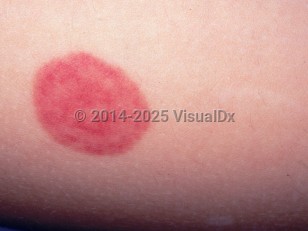Acute hemorrhagic edema of infancy
Alerts and Notices
Important News & Links
Synopsis

Acute hemorrhagic edema of infancy (AHEI), also known as acute hemorrhagic edema of childhood or postinfectious cockade purpura, is a leukocytoclastic vasculitis affecting children aged 4 months to 2 years. It is characterized by edematous hemorrhagic lesions of the head and distal extremities and is usually noted after an upper respiratory tract infection and/or a course of antibiotics. AHEI following COVID-19 infection has been reported.
Although the cause is unknown, it is thought to be an immune complex-related reaction to infection, drugs, or vaccination. Some consider it to be a variant of immunoglobulin A vasculitis (IgAV, formerly Henoch-Schönlein purpura); there are cases of children aged 2-4 years who have symptoms overlapping AHEI and IgAV.
AHEI is uncommon but reported worldwide. Most cases occur in winter.
Edema of the face is often seen initially, suddenly followed by skin lesions beginning distally and spreading proximally. The patient may have a low-grade fever but does not appear toxic. Systemic symptoms are rare, although joint, gastrointestinal (with bloody diarrhea), and renal (with hematuria and proteinuria) involvement may occur. Purpuric lesions can be painful.
Illness lasts 1-3 weeks and resolves without consequence. Recurrences may occur.
Although the cause is unknown, it is thought to be an immune complex-related reaction to infection, drugs, or vaccination. Some consider it to be a variant of immunoglobulin A vasculitis (IgAV, formerly Henoch-Schönlein purpura); there are cases of children aged 2-4 years who have symptoms overlapping AHEI and IgAV.
AHEI is uncommon but reported worldwide. Most cases occur in winter.
Edema of the face is often seen initially, suddenly followed by skin lesions beginning distally and spreading proximally. The patient may have a low-grade fever but does not appear toxic. Systemic symptoms are rare, although joint, gastrointestinal (with bloody diarrhea), and renal (with hematuria and proteinuria) involvement may occur. Purpuric lesions can be painful.
Illness lasts 1-3 weeks and resolves without consequence. Recurrences may occur.
Codes
ICD10CM:
D69.0 – Allergic purpura
P83.39 – Other edema specific to newborn
SNOMEDCT:
402856005 – Acute hemorrhagic edema of childhood
D69.0 – Allergic purpura
P83.39 – Other edema specific to newborn
SNOMEDCT:
402856005 – Acute hemorrhagic edema of childhood
Look For
Subscription Required
Diagnostic Pearls
Subscription Required
Differential Diagnosis & Pitfalls

To perform a comparison, select diagnoses from the classic differential
Subscription Required
Best Tests
Subscription Required
Management Pearls
Subscription Required
Therapy
Subscription Required
References
Subscription Required
Last Reviewed:02/12/2022
Last Updated:02/13/2022
Last Updated:02/13/2022
Acute hemorrhagic edema of infancy

